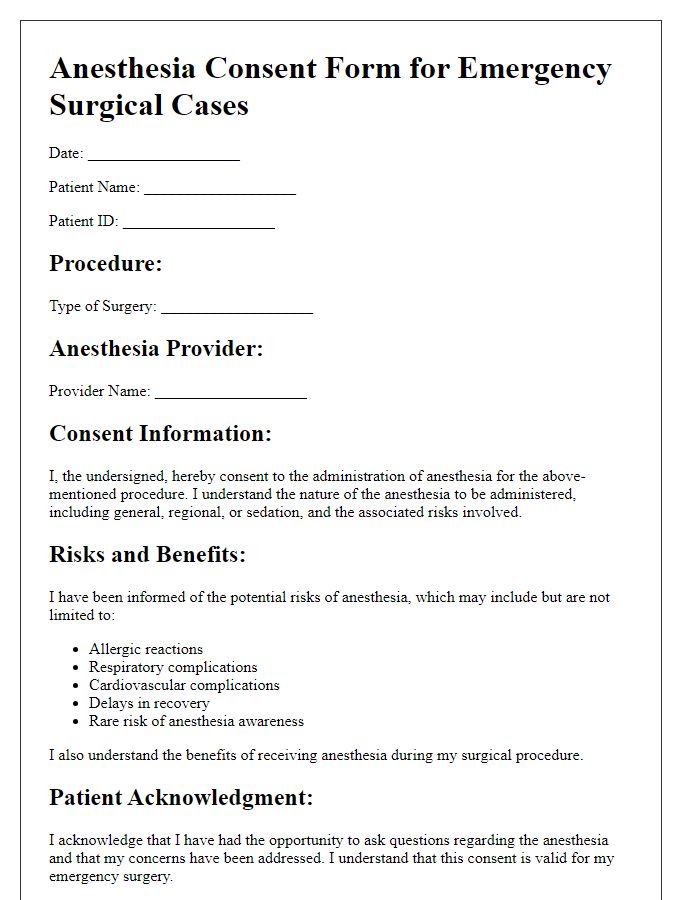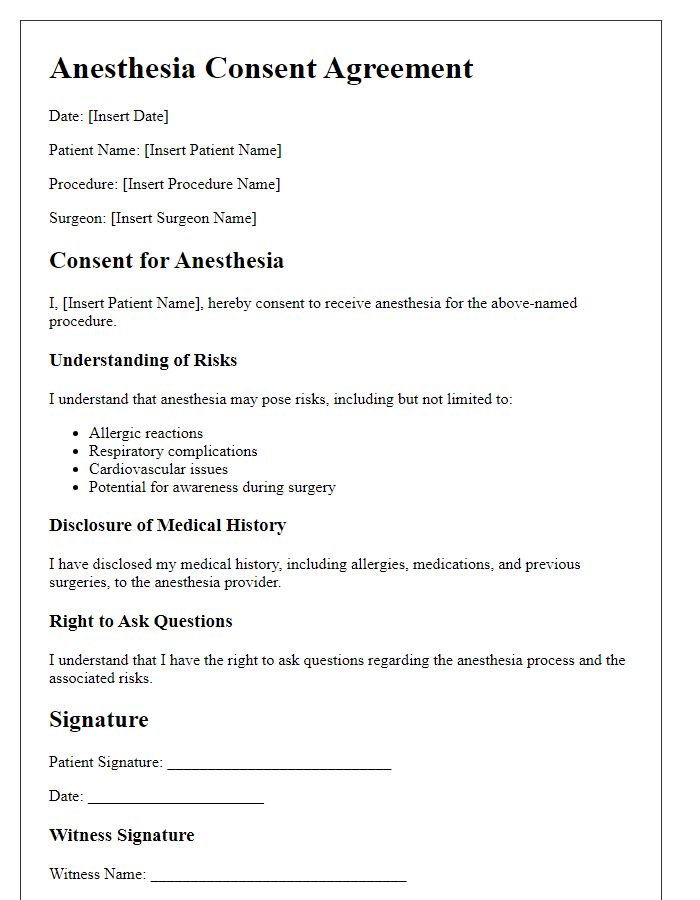When it comes to undergoing a medical procedure, understanding and consenting to anesthesia is crucial for your safety and peace of mind. A well-structured anesthesia consent form not only outlines the risks and benefits but also encourages open communication with your healthcare team. By ensuring you fully comprehend the details, you can feel more confident and informed about the upcoming procedure. Ready to dive deeper into this essential topic and learn how to create a comprehensive anesthesia consent template?

Patient Identification Information
Anesthesia consent forms are crucial for ensuring that patients understand the anesthesia process before undergoing surgical procedures. Patient identification information typically includes details such as the patient's full name, medical record number, date of birth, and contact information (including phone number and email). Additionally, the form might require the patient's address, insurance information, and emergency contact details. Collectively, this data is essential for accurately matching the patient with their medical records, ensuring proper communication regarding the procedure, and maintaining a safe and effective anesthesia administration process. The information also facilitates post-operative follow-ups and any necessary correspondence regarding anesthesia risk assessments.
Description of Anesthetic Procedure
The anesthetic procedure involves the administration of medication to ensure patients remain unconscious and pain-free during surgical interventions. Typically, general anesthesia administers agents such as Propofol, which acts rapidly to induce unconsciousness within seconds. Patients are continuously monitored throughout the procedure in a clinical setting, with vital signs tracked using advanced monitoring systems like electrocardiograms (ECGs) and pulse oximeters. An anesthesia provider, often an anesthesiologist or nurse anesthetist, oversees this process and will insert an intravenous (IV) line for medication delivery, often utilizing a combination of anesthetics based on the surgical procedure's nature, duration, and patient health history. The procedure typically occurs in a sterile operating room equipped with essential medical supplies and emergency equipment, ensuring patient safety throughout the process.
Risks and Complications
Anesthesia procedures carry potential risks and complications that must be acknowledged before undergoing any surgical intervention. Common risks associated with general anesthesia include respiratory difficulties, cardiovascular complications, and adverse reactions to anesthesia medications. For instance, some patients may experience postoperative nausea and vomiting, affecting recovery quality. Specific complications may include aspiration pneumonia, where stomach contents enter the lungs, potentially leading to severe respiratory distress. Local anesthesia processes can also pose risks like vascular injury or infection at the injection site, which may hinder healing. It is crucial to consider patient-specific factors, such as age, pre-existing medical conditions like hypertension or diabetes, and any previous surgery experiences, as these can influence overall anesthesia safety and effectiveness.
Benefits and Alternatives
Anesthesia administration presents numerous benefits, including enhanced patient comfort during medical procedures and effective pain management. General anesthesia renders patients unconscious and unresponsive, allowing for complex surgeries, such as orthopedic or cardiac operations, to be performed without discomfort. Meanwhile, regional anesthesia targets specific areas, providing pain relief while patients remain awake, suitable for procedures like knee arthroscopy. Alternatives to anesthesia include sedation techniques, where patients achieve a relaxed state but remain aware, allowing for some minor procedures to be conducted without full anesthesia. Additionally, local anesthesia numbs only a small region, appropriate for dental work or minor skin surgeries. Understanding these options assists in making informed decisions tailored to individual medical needs.
Patient Acknowledgment and Signature
Anesthesia consent forms are crucial documents in medical settings, outlining the risks and benefits associated with anesthesia administration during surgical or medical procedures. Patients, such as those undergoing operations at surgical centers or hospitals, must acknowledge understanding of potential side effects, such as allergic reactions, respiratory complications, or cardiovascular issues. The form also typically provides details about the type of anesthesia to be administered, which can include general anesthesia, regional anesthesia, or local anesthesia, each with its specific risks and benefits tailored to the patient's medical history. The signature at the bottom serves as a legal acknowledgment that the patient has received all necessary information and consents to the procedure, ensuring that medical professionals adhere to ethical standards and patient safety protocols during operations.
Letter Template For Anesthesia Consent Form Samples
Letter template of anesthesia consent documentation for pediatric patients.

Letter template of anesthesia consent form for emergency surgical cases.

Letter template of anesthesia consent form for regional anesthesia procedures.

Letter template of anesthesia consent verification for spinal surgeries.










Comments